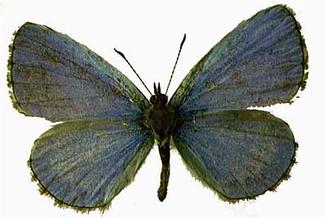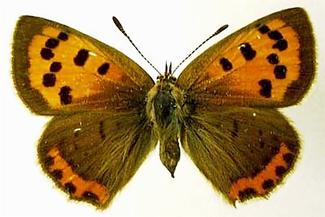
 |


Habitat
Adults: terrestrial
Immatures: terrestrial
Feeding Habits
Adults: nectar and pollen feeding
Immatures: phytophagous
Size: 11 to 47 mm
Flight : strong flier
North American
Species: 160
|
Lepidoptera Lycaenidae
Coppers, hairstreaks, blues and harvesters.
Front Wings: scaled
Hind Wings: scaled
Mouthparts: sucking
Antenna Length: shorter than body
Antenna Shape: straight
Front Legs: unmodified
Hind Legs: unmodified
Special Characteristics:
Small delicate butterflies that are often brightly coloured. They have a slender body, the antennae are ringed with a white stripe, and their eyes are circled with white scales. The bases of the antennae touch the eyes. Some species have a small tail at the end of the hindwing. The females have normal front legs but in the males they are reduced and lack tarsal claws. The larvae are flattened and sluglike.
|
|
Species:
Celastrina ladon (Cramer)
Common Name:
Spring azure
Feeding Habits: The larvae feed on a variety of white-flowering trees and shrubs.
Distribution:
Widespread in Canada.
Comments:
The larvae are usually green but can also be yellowish brown or reddish brown with a darker middorsal stripe. This is the most common and widespread species in this group. It has a 18 to 28 mm wingspan, and is a pale blue butterfly with a blackish-grey border on the forewing in the females. The adults are often seen in open woodlands and along woodland margins where flowering shrubs are common.
|

|
|
Species:
Lycaena phlaeas (Linnaeus)
Common Name:
American copper
Feeding Habits: The adults feed on nectar and are often found on goldenrod flowers. The larvae feed on sheep sorrel and on dock.
Distribution:
Widespread in Canada.
Comments:
The larvae are covered with downy hair and are yellowish-green with red or white stripes. The adults are territorial and aggressive and will often "buzz" to chase off other butterflies from their territory.
|

|